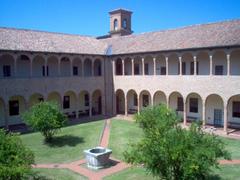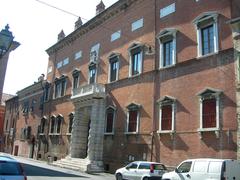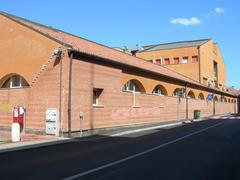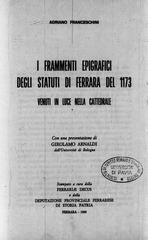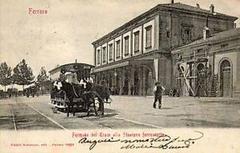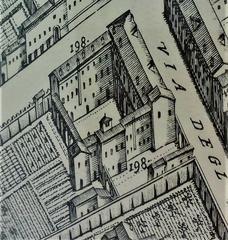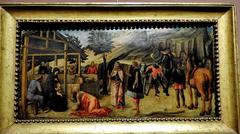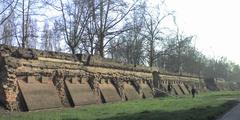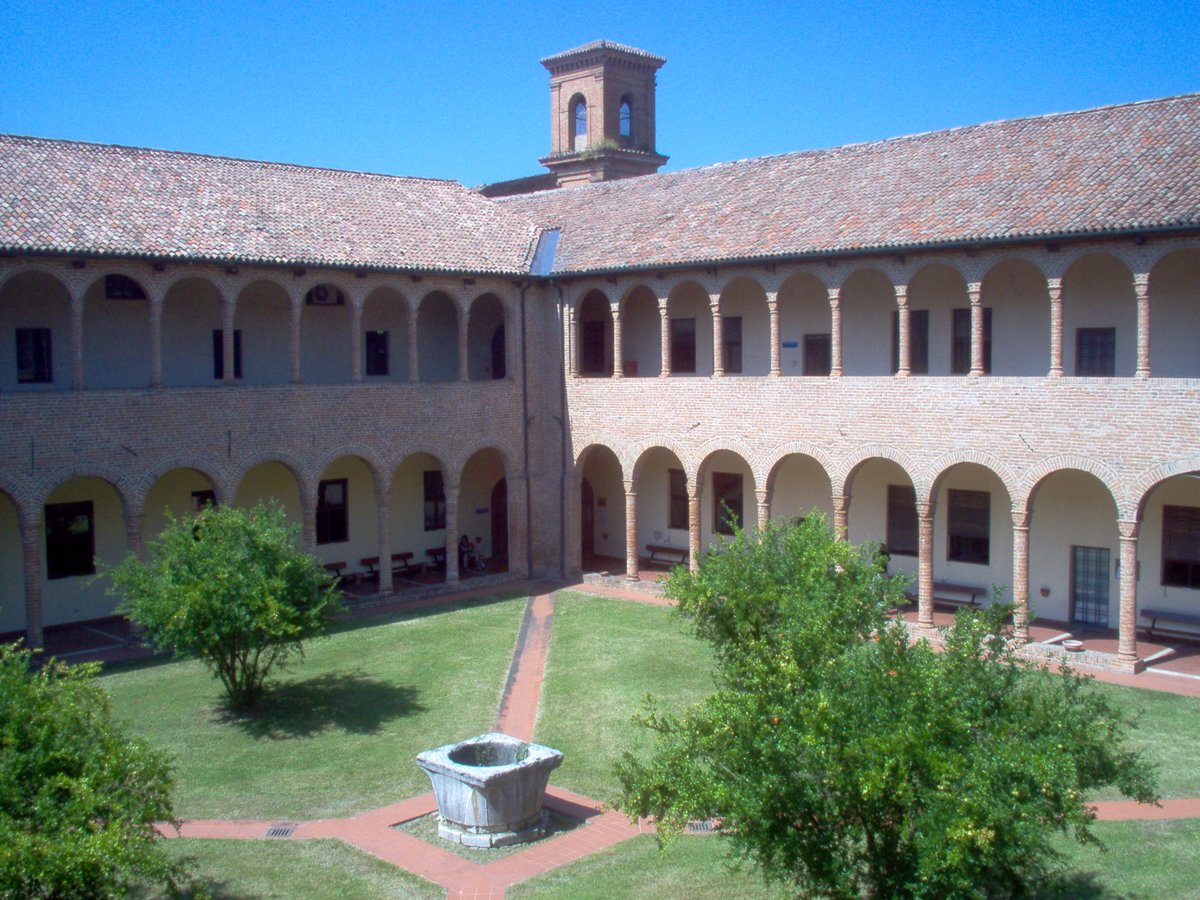
University of Ferrara Visiting Hours, Tickets, and Historical Site Guide
Date: 14/06/2025
Introduction
Nestled in the UNESCO-listed heart of Ferrara, Italy, the University of Ferrara (Università degli Studi di Ferrara, UniFE) stands as a testament to over six centuries of academic excellence and architectural grandeur. Established in 1391 under the Este dynasty, the university has not only shaped the city’s intellectual landscape but also contributed to Ferrara’s rise as a Renaissance capital. Its campuses are seamlessly integrated into the historic urban fabric, occupying centuries-old palaces and convents, and offering visitors an immersive journey through both academic and cultural history (University of Ferrara Visiting Hours, Tickets & Historical Guide; University of Ferrara: Visiting Hours, Tickets, and Exploring Ferrara’s Historical Sites).
This guide details everything you need to plan your visit: from opening hours and ticketing options to accessibility, campus landmarks, practical travel tips, and highlights of Ferrara’s vibrant cultural scene. Whether you are a history enthusiast, prospective student, or cultural traveler, use this guide to explore both the University of Ferrara and its surrounding Renaissance treasures (Visiting the University of Ferrara: Hours, Tickets, and Nearby Historical Sites in Ferrara; University of Ferrara: Visiting Hours, Tickets, and Exploring Ferrara’s Historical Sites).
Table of Contents
- Introduction
- Historical Development
- Campus Landmarks & Architectural Significance
- Visiting Hours, Tickets & Accessibility
- The University’s Role in Ferrara’s Culture
- Practical Visitor Tips
- Nearby Attractions
- Seasonal Events
- Frequently Asked Questions (FAQ)
- Preservation and Innovation
- Conclusion
Historical Development
Founded in 1391 by Alberto V d’Este with papal approval, the University of Ferrara quickly became a magnet for intellectuals, including Nicolaus Copernicus and Paracelsus (pavaedu.com). The Este dynasty’s patronage fostered a vibrant academic environment, and the university grew alongside Ferrara’s transformation into a major Renaissance center. The institution’s expansion paralleled the city’s urban evolution, resulting in a campus interwoven with Ferrara’s network of palaces, convents, and public spaces (Ferrara Historic Centre).
Campus Landmarks & Architectural Significance
Renaissance Urban Integration
Ferrara’s Addizione Erculea (1492) redefined urban planning, with the university’s buildings distributed throughout the city’s broad avenues and grand squares. This unique “city-campus” model allows students and visitors to experience academic life amid living history, where daily routines unfold in buildings rich with Renaissance and medieval heritage (UNESCO Ferrara).
Notable University Buildings
Department of Architecture (Via Ludovico Ariosto 35)
Housed in elegantly restored Renaissance structures, this department is renowned for its innovative programs and regularly participates in public events and open days (UniFE Architecture).
Palazzo Renata di Francia
This Renaissance palace, once home to Este nobility, now serves academic and administrative purposes. Its frescoed halls are accessible to visitors during special events and open days—verify visiting hours in advance.
Biblioteca Ariostea (Palazzo Paradiso)
A 15th-century architectural gem, the Ariostea Library features grand reading rooms and priceless manuscripts. It is open to the public, generally Monday to Friday, 9:00 AM to 7:00 PM, with hours subject to change (Ferrara Info).
Other Historic Sites
Several university faculties are housed in converted convents and palaces, such as the ex-Convento di San Romano and Palazzo Bonacossi, each adorned with period details and artworks. Access may be limited; check with the university for current visitor policies.
Visiting Hours, Tickets & Accessibility
- General Hours: Most university buildings are open Monday to Friday, typically 9:00 AM – 6:00 PM. Specific sites, like the Ariostea Library, may have extended or reduced hours. Always confirm before visiting.
- Admission: Entry to most public spaces, including libraries and administrative buildings, is free. Special exhibitions or guided tours may require a ticket, generally ranging from €5 to €12.
- Guided Tours: Available during academic open days and cultural festivals; advance booking via the university website or local tourist offices is recommended.
- Accessibility: Ferrara’s flat terrain and extensive cycling lanes make it easy to navigate. While many university buildings feature ramps and lifts, some historic sites may have steps or uneven surfaces. Contact individual venues for detailed accessibility information (Dan Flying Solo).
The University’s Role in Ferrara’s Culture
From the Renaissance to the present, the university has shaped Ferrara’s cultural identity. It nurtured figures such as Ludovico Ariosto and Torquato Tasso, and remains a vibrant center for research and innovation. Today, the university partners with local institutions to host lectures, exhibitions, and music festivals, while supporting international exchange and research initiatives (EAAE Ferrara).
Practical Visitor Tips
- Getting Around: Walking and cycling are the most convenient ways to explore Ferrara’s compact center and university sites. Bike rentals are available near Este Castle and major squares (Dan Flying Solo).
- Dining: Enjoy local specialties—try cappellacci di zucca or salama da sugo at eateries near the university. “Al Brindisi,” reputedly the world’s oldest wine bar, is a unique stop (savoringitaly.com).
- Accommodation: Numerous hotels, guesthouses, and student dorms are located within walking distance of university buildings and city attractions (123university.net).
- Safety: Ferrara is considered very safe; standard travel precautions apply.
Nearby Attractions
- Castello Estense: Ferrara’s iconic moated castle, open daily with guided tours available (Castello Estense Official Website).
- Ferrara Cathedral: A Romanesque-Gothic masterpiece in the city center.
- Palazzo dei Diamanti: Renowned for its diamond-pointed façade and major art exhibitions.
- Botanic Garden: One of Italy’s oldest, featuring over 1,300 plant species (Wikipedia).
- Jewish Ghetto and Via delle Volte: Atmospheric medieval neighborhoods.
Seasonal Events
- Ferrara Buskers Festival (August): International street music festival.
- Palio di Ferrara: Italy’s oldest historical reenactment, with vibrant parades and competitions.
- Art and Literary Festivals: Hosted throughout the year at university and city venues (Ferrara Info).
Frequently Asked Questions (FAQ)
Q: Are university buildings free to visit?
A: Most are free; special exhibitions and guided tours may require a ticket.
Q: What are the typical visiting hours?
A: Weekdays, 9:00 AM – 6:00 PM for most sites. Libraries may close later; always check current schedules.
Q: Is the university accessible to people with mobility issues?
A: Many sites are accessible, but some historic buildings have limitations. Contact venues in advance for details.
Q: How do I get around Ferrara?
A: Walking and cycling are recommended; the city is flat and compact.
Q: Are guided tours available?
A: Yes, especially during festivals and university open days. Book via the university website or local tourist offices.
Preservation and Innovation
The University of Ferrara excels in maintaining a delicate balance between historic preservation and modern functionality. Its adaptive reuse of heritage buildings for academic purposes allows visitors to engage with living history in a dynamic university setting (EAAE Ferrara).
Conclusion
The University of Ferrara offers visitors a rare fusion of academic prestige, Renaissance heritage, and vibrant city life. With well-structured visiting hours, mostly free access, and a wealth of cultural and historical attractions nearby, it’s an ideal destination for those seeking to explore Italy’s rich intellectual and artistic traditions. Plan your visit using up-to-date information from the official university website and the Ferrara tourism portal. For guided audio tours and event updates, download the Audiala app.
Sources
- University of Ferrara Visiting Hours, Tickets & Historical Guide
- Visiting the University of Ferrara: Hours, Tickets, and Nearby Historical Sites in Ferrara
- University of Ferrara: Visiting Hours, Tickets, and Exploring Ferrara’s Historical Sites
- Visiting the Castello Estense in Ferrara: Hours, Tickets, and Tips for an Unforgettable Experience
- University of Ferrara: Visiting Hours, Tickets, and Exploring Ferrara’s Historical Sites, Pava Edu
